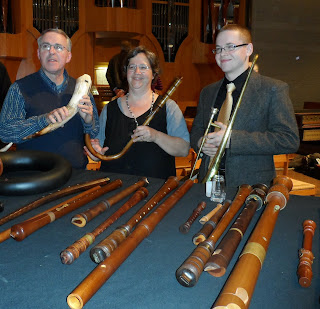Click on any picture to see it full size; use the back arrow or the ESC key to return to this page.
On Monday, March 11, 2013, the Northern Virginia and Potomac Chapters of the American Guild of Organists presented the program
The Instruments Your Organ's Stops Were Named For
at
St. Luke's Catholic Church, McLean, Virginia
Paul Skevington, Director of Music, was our Host
Potomac SubDean Emily Koons introduced the musicians:
From the College of William and Mary in Williamsburg, Virginia, Tom Marshall, organ, holding a Gemshorn, Ruth van Baak Griffoen, holding a Krummhorn, and talented student Patrick Dittamo, holding a Sackbut.
Here is a description of the event by Past Dean Carol Dennis:
SACKBUTS, SERPENTS AND SHAWMS, OH MY!
Carol Dennis
One
Monday evening in March, my husband and I trekked across the river to St.
Luke’s Catholic Church in McLean, VA, to attend the combined meeting of the
Potomac and Northern Virginia AGO chapters.
There we learned about the mysterious instruments that are used as names
for those mysterious stops on the pipe organ.
“Organ Stops & Their Origin,” may sound dry, but our presenters from
the College of William and Mary, Early Music specialist Ruth van Baak Griffoen,
organist Tom Marshall, and talented student, Patrick Dittamo, made it exciting.
They
demonstrated the Recorder which dates from the Middle Ages and long preceded
the modern transverse orchestral flute. The
Recorder (Blockflöte in German) ranges in size from six inches to over nine
feet in length. We were treated to a Consort of Recorders when our presenters
played a hot dance tune from the 1500s.
(editor's note: Ruth also demonstrated the difference between the recorder and the traverse flute, which is the ancestor of our present orchestral flute.)
Everyone
recognizes the trombone, but what if it has a narrower bell like those played
by angels on Christmas cards? That’s a
Sackbut (Posaune in German), and the sound is softer and sweeter than our
modern trombone. Bach’s Arnstadt organ
had a 16 foot posaune pedal rank.
The
Cornett (Zink) is a woodwind instrument with brass-style mouthpiece. It was highly popular in the 1600s and was the
soprano of the family.
The tenor has a
slight curve and is called a Lizard; best of all, the bass member is called the
Serpent.
The
Shawm (Schalmei) became the oboe and was used as an organ stop as early as 1509. It makes a wonderfully haunting solo stop if
the timbre is not “snarling.” We have
the double-reed Rauschpfeife that is loud and rude. There’s the reedy, nasal Crumhorn (Krummhorn)
shaped like an upside-down cane and dating as an organ stop from 1489.
We mustn’t forget the Gemshorn
(Gemsserhörner) recorders that originally were made from the horns of goats and
date from 1511 as organ stops.
Then
there are the strings. The Viola da Gamba
is the high-class cousin of the future violin, the Viola da Braccio (on the
arm). They developed side by side but
were never the same instrument.
The Viola da Gamba (on the leg) is played on
the lap or between the legs much like the modern cello. It is bowed underhand and has a softer,
sweeter tone than the modern violin. Bach’s
Arnstadt organ had a viola da gamba stop.
The
AGO program was fun and educational. We enjoyed
hearing the early instruments and comparing them with organ stops. What a wonderful world of sound they make. How lucky we are to have them as stops on our
King of Instruments.
All of the instruments used in the program were out for display afterwards, so we could see all of them and how they differ from those we use today.
Following the program there was a reception in the church's fellowship hall.















